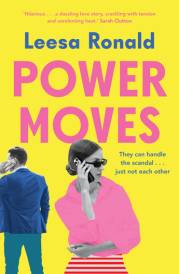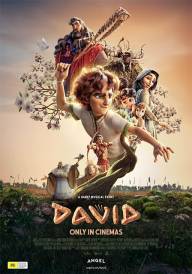Nicolas Duval-Adassovsky, Laurent Zeitoun and Yann Zenou Ballerina Interview
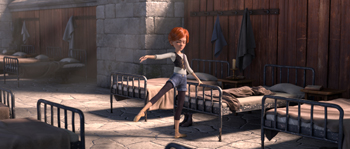
Nicolas Duval-Adassovsky, Laurent Zeitoun and Yann Zenou Ballerina Interview
Cast: Elle Fanning, Dane DeHaan, Maddie Ziegler, Carly Rae Jepsen
Director: Eric Summer, Éric Warin
Genre: Family
Rated: G
Running Time: 85 minutes
Synopsis: Félicie is a young orphan from Brittany with only one passion: dance. With her best friend Victor, who wants to become a great inventor, they devise a madcap plan to escape the orphanage for Paris, the City of Lights where the Eiffel Tower is still being built! Félicie will have to fight like never before to surpass herself and to learn from her mistakes, to make her wildest dream come true: becoming a prima ballerina at the Paris Opera...
Ballerina
Release Date: January 12th, 2017
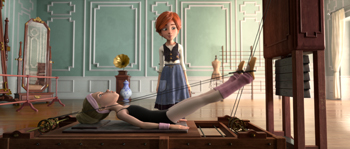 Nicolas Duval-Adassovsky, Laurent Zeitoun and Yann Zenou Ballerina Interview
Nicolas Duval-Adassovsky, Laurent Zeitoun and Yann Zenou Ballerina Interview
Question: What was the point of departure for the Ballerina adventure?
Yann Zenou: In 2010, Eric Warin and Eric Summer presented us with the pitch and the preliminary sketches for a project that was at the time entitled La véritable histoire des petits rats de l'Opéra ('The True Story of the Petit Rats at the Opera"). We immediately fell in love with that little girl who escaped from her orphanage to come to Paris and enroll at the Opera. We had the beginnings of a beautiful story, but everything else remained to be done.
Laurent Zeitoun: The result was three years of questioning, wondering about how to concretize a film equal to our expectations… A film that puts a spotlight on Paris, and during an era that we don't often see at the movies: Baron Haussmann's renovations were still underway, and the Eiffel Tower and Statue of Liberty were still being built.
Yann Zenou: And so we set off with flowers in our rifles, and with no experience whatsoever in the field of animation. We were lucky enough to have the support of people who believed in us.
Laurent Zeitoun: It was only in 2013 that the project took off again, this time with a new title: Ballerina. Everything had finally gelled to make the adventure come true. This experience was a veritable marathon for us, and the work that needed to be done was gigantic! That marked us. From then on Ballerina was our baby. We saw it being born, mature, and grow up. We were almost afraid to lay siege to the movie theatres, even though we were persuaded that children, that families would adopt it as a part of their dreams.
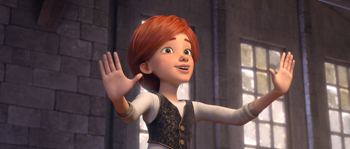 Question: Some producers prefer simply to speak of their -film', rather than differentiate between animation and a live action film…
Question: Some producers prefer simply to speak of their -film', rather than differentiate between animation and a live action film…
Laurent Zeitoun: The main thing is to tell a great story about a hero with whom we can live and vibrate. At the beginning of the project, we did not raise any questions about the particularities of the world of animation.
Nicolas Duval-Adassovsky: We've been asked why we didn't decide to film it as a live action movie. The answer is very simple: animation lets you reach a different, wider audience. The idea that a film will speak to the entire family, to parents and to children too, is very gratifying. We already realized that kids had loved some of our romantic comedies, such as Eyjafjallajokull. We wanted to speak to them more and more, and to adults who have remained children too… beginning with ourselves and our own kids!
Yann Zenou: For us, cinema means sublimating the real world to understand it better and accept it. Along with our imaginations, animation is the ideal way to express our dreams. I thinkthat the first film we make in our heads as children is a cartoon that bridges the real world and our imaginations. A cartoon is what links childhood and the world of adults.
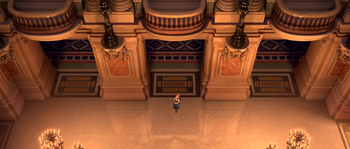 Question: How did the creative process proceed?
Question: How did the creative process proceed?
Laurent Zeitoun: We wanted the result to be flamboyant, up to the animation standards of the American studios. We wanted Ballerina to be mass entertainment, we wanted it upbeat and full of life.
Yann Zenou: And the message is just the opposite of what the Mother Superior says at the orphanage: 'Dreams never come true. They're only illusions… Life is ruthless". The basic pitch nudged us toward high drama, but what guided us even more was our desire to tell children in a lighthearted way never to give up on your dreams. That little phrase accompanied us every day in our work as producers.
Laurent Zeitoun: Ultimately, the creative process proceeded naturally thanks to a team of great professionals who joined us on the film.
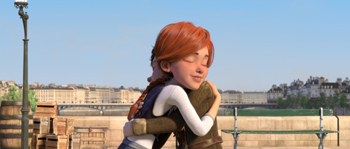 Question: How did the dance milieu become the perfect vector?
Question: How did the dance milieu become the perfect vector?
Nicolas Duval-Adassovsky: Laurent does classic dance, so there was no way out. (laughter)
Laurent Zeitoun: And I can prove it with a grand jeté that would land me directly in the hospital! Joking aside, involvement in classic dance is an endless combat, including a combat against your own self: it requires so much rigor, self-sacrifice, and suffering, that giving it up amounts to total defeat. The discipline remains a kind of Mount Everest in the world of sports and the arts. If you're not solidly attached to your dream, you'll give up…
Yann Zenou: … And since no one ever achieves perfection, dancers never cease to tirelessly pursue their Holy Grail. Our choreographers brought us that perfection. Aurélie Dupont and Jérémie Bélingard played a capital role in bringing the experience of classic dance alive in the film.
Nicolas Duval-Adassovsky: From a visual point of view, it is an extremely cinema-friendly discipline. Watching it is an incredible experience. Animating it for a film is tantamount to sublimating it. All the pirouettes that Félicie and the others perform are twice as much larger than life as compared to reality. Animation often requires some exaggeration of reality: that was for example the case of all the characters imagined by Eric Warin, who were then passed on to 'character artists" in charge of refining, indeed exaggerating their features. Their eyes for example.
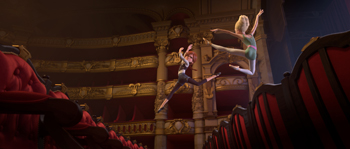 Question: How did you manage to make the petits rats' pirouettes look both realistic and magical?
Question: How did you manage to make the petits rats' pirouettes look both realistic and magical?
Laurent Zeitoun: We began by testing 'motion capture", fitting out a dancer - in this case Aurélie Dupont - with sensors that transmit points of movement to a computer. Strange to say, the first results conveyed a feeling of inertia, even though they were a faithful reproduction of what the dancer was actually doing.
Yann Zenou: There was really nothing magical about motion capture!
Laurent Zeitoun: We quickly abandoned that option, and even more so since our points of reference were studio films in which motion capture was never used. We were looking for greater sophistication, greater dynamism regarding both dance and emotions. The 'keyframe" technique, that is to say animation by keyframes allowed us to meet that objective – thanks to Ted Ty, our animation director, who had worked for Disney and DreamWorks.
When you see Félicie and Camille dance onscreen, their movements are twice as quick and broad as in real life. That is how we were able to stick to the 'larger than life" nature of the story and animation. The final duel in which the two rivals move from the stage to the auditorium, and then to the grand staircase at the Opera is a perfect example.
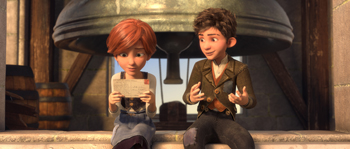 Question: Which 'great studio films" did you have in mind?
Question: Which 'great studio films" did you have in mind?
Yann Zenou: Ballet has rarely been seen in cartoons, with the exception of some passages in Fantasia. We had in mind mainly films that deal with outdoing yourself, like Karaté Kid and Billy Elliot. Personally, I would also cite Rocky!
Nicolas Duval-Adassovsky: As for animated feature films, let's not forget Ratatouille, which had blown us all away, or Tangled, with its incredible inventiveness and humor.
Question: When you tackle animation, one of the pitfalls is to think that your craziest imaginings have become possible…
Yann Zenou: You tend to think that anything goes, but your very real budget soon catches up with you! Animated feature films can cost up to 200 million dollars. We only had 30 million. To make our Ballerina dreams come true, we had to put on our thinking caps, ponder, explore, and invent quite a few artistic solutions.
Nicolas Duval-Adassovsky: Making choices is the law of the film world. I don't think that any one of us three has any regrets. Budget constraints forced us to become creative in terms of design, costumes and narration.
Yann Zenou: We needed to reduce the size of certain decors, conflate scenes, which in the long run made them more effective. That improved the film's pace and dramatic intensity.
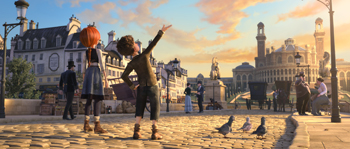 Question: What was involvement as a threesome like when developing the script?
Question: What was involvement as a threesome like when developing the script?
Yann Zenou: The process took some time. The screenplay was finalized by Laurent and Carol Noble. We were able to look for finance on the basis of that scenario, and then we went on to the storyboard stage, during which some more questions arose regarding the screenplay. In animation, you don't waste any shooting time: you can't correct errors or fix weak spots during the edit!
Each stage of our story boarding was the object of weekly discussion among us. Once a sequence was validated, it was played using temporary voices. If we were not totally convinced, Laurent and Carol would then rework the scene.
Nicolas Duval-Adassovsky: It was a particularly joyous work period and it lasted a year and a half. It was like editing the film before it was shot. We talked it over a lot before reaching common accord. So it's impossible to know who was responsible for what, even though Laurent was at the origin of the screenplay, character development and twists and turns in the plot.
Laurent Zeitoun: In short, I proposed and the other two disposed! With a basic theme that we all cared deeply about: an impassioned declaration of love for Paris. But none of it would have seen the light of day without the teams that worked with us.
Question: Why was it the heart of the project?
Laurent Zeitoun: To be honest, Yann wanted the story to take place in Charenton, because that's where he's from.
Yann Zenou: I argued for the Bois de Vincennes, but that wasn't close enough!
Laurent Zeitoun: When you were born in Paris, you sometimes forget that it's one of the most beautiful cities in the world. All you need to do is to stand somewhere for a few minutes, look around and realize that you're living in an open air museum that people still dream about. People talk about the City of Lights, the city of love, romance, the arts. Setting our story in the Paris of Gustave Eiffel meant resurrecting the magic, history, and mythical aspects that have perhaps faded a bit. It's also internationally more glamorous than Charenton!
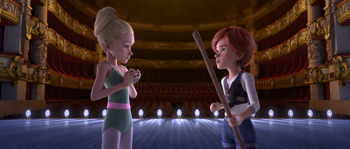 Question: When you stroll through the Paris of 1879, you can't help being overcome by the sumptuousness of its decors and the luxuriant details!
Question: When you stroll through the Paris of 1879, you can't help being overcome by the sumptuousness of its decors and the luxuriant details!
Yann Zenou: We waited a long time to discover that as a whole. It was the result of our art director Florent Masurel's vision. He literally lived in the Paris of the era: he spent six months on staggering archive research, both visual and graphic.
He didn't miss one photo. He examined paintings, engravings, literature. He dissected the social and political context, he studied every street, every profession. His guiding light was the transformations that were then going on in the capital thanks to Baron Haussmann, who had begun by widening squares and avenues.
Nicolas Duval-Adassovsky: Paris was one huge construction site. It is touching to share that reality with the youngest members of the audience…
Question: … With the Opera the star of the show.
Laurent Zeitoun: It had been built ten years earlier. Florent found all the original blueprints in the Opera archives. We called on independent architects to recreate the structure of the building, and then make a model of it. Everything in the film was worked up as a model: it was a Herculean task!
Nicolas Duval-Adassovsky: The technical crew at the Atelier studio had the brilliant idea of creating a Paris kit by juxtaposing building facades that, aside from the astounding realism, facilitated production. Those were the kind of brainwaves that helped us to respect the budget, while maintaining visuals worthy of a blockbuster production.
Laurent Zeitoun: At first, we were more or less left to our own devices, which prompted us to open our own animation studio in Montreal…
Yann Zenou: … Laurence Vacher, who had a lot of experience in animation, left for Montreal, where she recruited a crew especially for our film. At the height of its activity, the studio employed close to 200 people.
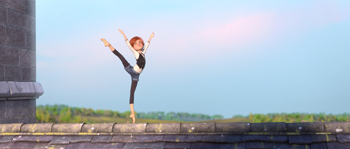 Question: Is the studio meant to be permanent?
Question: Is the studio meant to be permanent?
Yann Zenou: We hope so!
Laurent Zeitoun: Our passion for animation came alive in the course of Ballerina. We were bowled over by the amount of teamwork that was needed, the necessary sum of competences and experience…
Yann Zenou: … And which corresponded to our own way of working. Nicolas Duval-Adassovsky: Ballerina is a group achievement in the literal sense of the term. Each one of us brought his or her ideas and know-how. At times we met on an everyday basis to discuss the story-board, animation and direction. Participating as producers in such an active way during the various creative stages was exhilarating.
Trust is crucial in such a long adventure, and complementary competences are essential: for example, Guillaume Ivernel took care of artistic production by supervising the development of all the drawings, François-Xavier Aubague, our line producer, kept one eye on all the artistic issues and another on the budget…
Question: You also indulged in some scenes in which the action is as crazy as a Tex Avery cartoon, such as the escape from the orphanage, or the antics at the top of the Statue of Liberty…
Laurent Zeitoun: Yann, Nicolas and I found ourselves carried back to our childhoods. We plunged into our memories as audience members: which scenes thrilled us? Copying them was out of the question, but we wanted to reconnect with that kind of spontaneous emotion. Félicie and Victor's chase scene is right out of Indiana Jones.
With the thrilling idea that the heroes are having fun as they hurt themselves, smirking all the while.
The final combat is in the same vein, a bit mad, and totally wild. If thanks to that scene, young children learn that the Statue of Liberty was built in France as a gift to America, we will be pleased as punch!
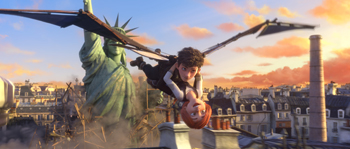 Question: What helped you to hang in there during all those years of production?
Question: What helped you to hang in there during all those years of production?
Laurent Zeitoun: The question is not whether there were moments of doubt, it's whether there were some moments during which we felt reassured!
Yann Zenou: Being a trio was crucial, because each of us could take turns relying on the energy of the other two.
Nicolas Duval-Adassovsky: Getting through the pleasures as well as the ordeals together made the experience even more exhilarating. I don't feel like I've really suffered from the waiting, or the slowness of the process, but with hindsight, the constant accumulation of minor worries did require quite a lot of perseverance.
Yann Zenou: There was no real waiting, because the various creative stages succeeded one other, and so we never felt we were facing a creative vacuum. In the meantime, we also produced six 'live action films". But for our next animated film, we'll try to take less time!
Question: Is there a sensibility, a French touch that differentiates Ballerina from American productions?
Nicolas Duval-Adassovsky: We were often told that any self-respecting animated film needs to have animals that talk, and heroes who break into song. We preferred to bank on the realism of the story, the coherence between the characters and the course of their adventures.
Laurent Zeitoun: It's hard to distinguish influences. Nothing was premeditated, either in terms of remaining French, or of fitting into American patterns. The three of us racked or brains to tell a story that relies on a wide range of emotions.
Yann Zenou: We never asked ourselves what the big studios would have done in our place. We made the film that we would like to see as members of the audience. The fact that all three of us are French probably did play a role, subconsciously!
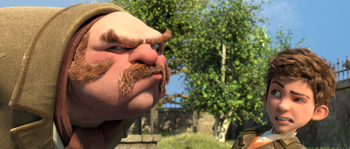 Question: Which moments of the film left an impression on your minds?
Question: Which moments of the film left an impression on your minds?
Laurent Zeitoun: The greatest shock was to see, after all those years during which the characters were animated in shades of grey, the explosion of color once the textures were laid down and the lighting adjusted. Everything we had fought for over four years suddenly made sense.
Yann Zenou: I still feel a lot of emotion and excitement when I see Félicie's class scenes, and then those in which she rediscovers Odette. When you tell the story of a little girl who fights for her dreams, you focus on the universal theme of self-realization with all the disillusionment and aggressiveness it implies.
Nicolas Duval-Adassovsky: I love the positive energy that the film exudes. Félicie does not succeed by destroying the people around her: she has a personal path to follow. She learns to know herself, to be in accord with her roots, with her heritage.
Yann Zenou: Félicie does not achieve her dream until the day she understands viscerally what makes her want to dance. Which gives meaning to the success that each of us wants to obtain: that is a value that has united us since we've known each other and that profoundly connects us to Ballerina.
Question: Have all three of you discovered the meaning of what motivated you as producers?
Nicolas Duval-Adassovsky: From the start, I think that it was our choice of a beautiful story. What makes us happiest about Ballerina is having engaged the audience's emotions. Especially children's.
Yann Zenou: In that sense, when we see audience reactions in the theaters, all the ordeals we went through fade away. The film has been sold all over the world, which implies openness to different types of audiences and cultures.
Laurent Zeitoun: I'm always on the alert for an adventure, with all the personal and professional discoveries it generates. Ballerina and all the films we have been lucky enough to produce have one thing in common: characters that evolve, who have a compelling story, and whose fate we want to watch. But even more so, the opportunity of working with exceptional talents.
Ballerina
Release Date: January 12th, 2017
MORE
- Mission: Impossible Fallout
- Glenn Close The Wife
- Allison Chhorn Stanley's Mouth Interview
- Benicio Del Toro Sicario: Day of the Soldado
- Dame Judi Dench Tea With The Dames
- Sandra Bullock Ocean's 8
- Chris Pratt Jurassic World: Fallen Kingdom
- Claudia Sangiorgi Dalimore and Michelle Grace...
- Rachel McAdams Disobedience Interview
- Sebastián Lelio and Alessandro Nivola...
- Perri Cummings Trench Interview

